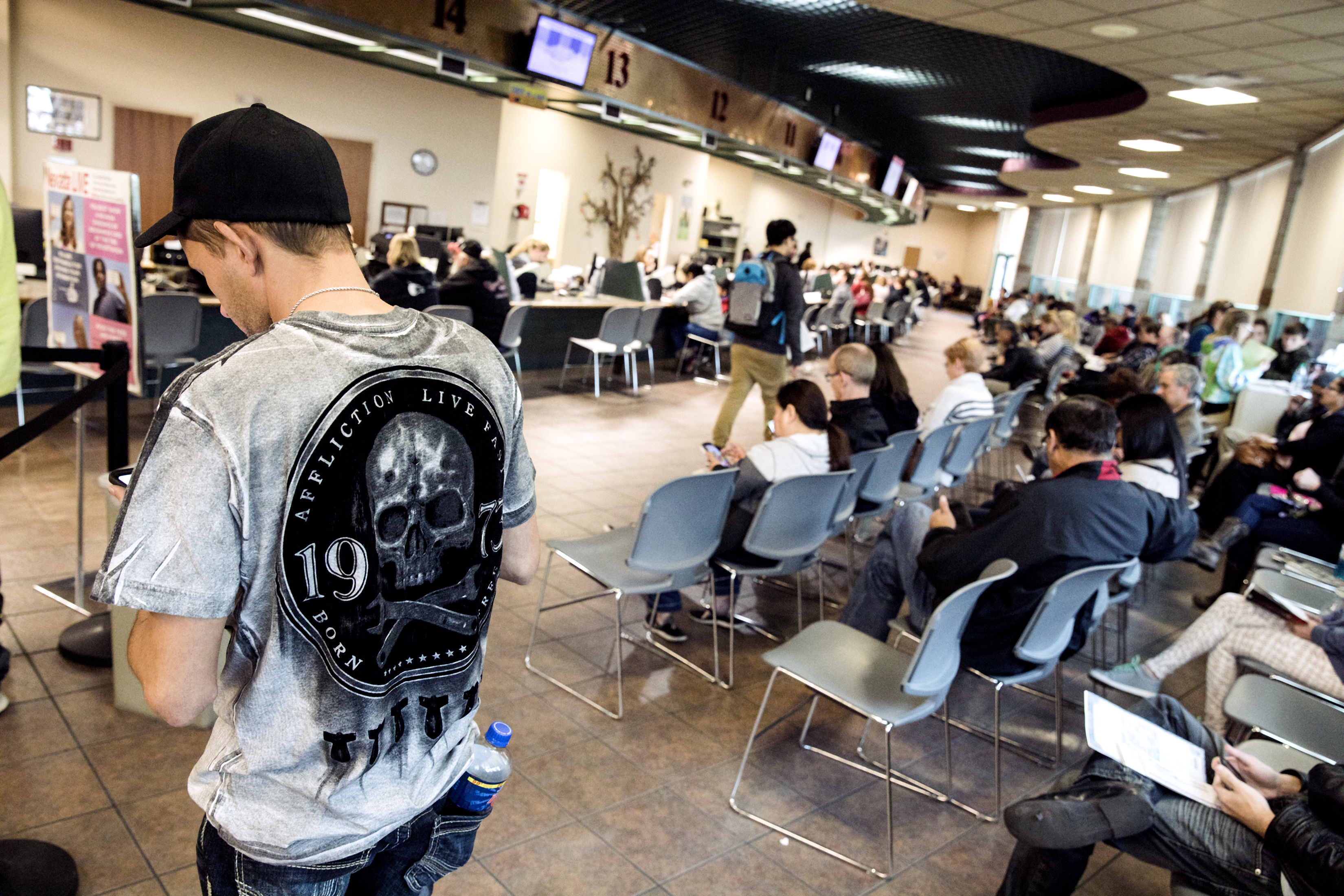New same-day and automatic voter registration laws helped drive record participation in Nevada election

In October, the secretary of state reported there were more than 1.8 million active registered voters in Nevada, a record number for the state. Record registration numbers coincided with record participation, as the state has reported more than 1.3 million Nevada voters cast ballots in this year’s election.
And those October numbers aren’t a complete picture of how many active registered voters had the opportunity to participate in Nevada’s election, as thousands registered in-person on Nov. 3 through the state’s new same-day registration system.
Same-day voter registration and automatic voter registration were two major changes that took effect this year, compounding changes brought on by the pandemic-driven shift toward mail-in voting and making this past election unlike any other in Nevada.
But with these new opportunities for registration there still came inconveniences.
Physical DMV offices closed in the state on March 17 as a result of the coronavirus pandemic and remained largely closed through June 15, limiting transactions that are necessary for many individuals in the state to register to vote. The Nevada Republican Party has pointed to individuals who say they were prevented from voting because they were new residents and were unable to obtain IDs needed to register on Election Day.
Representatives of the department said they aren’t aware of anyone who was turned away or denied service. They noted they’ve been working to provide services for anyone who hadn’t been able to access DMV services during closures.
In Nevada, Oct. 6 was the deadline for registering to vote in-person or by mail, and Oct. 29 was the deadline to register to vote online. To register online or in-person during early voting or on Election Day, individuals must have a Nevada state ID.
From Oct. 10 to Nov. 3, the DMV in Nevada expanded walk-in hours for new residents. Typically, without an appointment, new residents are able to walk in on Saturdays from 7:30 a.m. to 3:30 p.m., but the schedule change added two-hour walk-in periods every morning, Monday through Friday. On Election Day, the DMV also allowed new residents to walk-in all day as long as they surrendered an out-of-state license or ID.
DMV Director Julie Butler said these decisions were made to help address a “backlog” of new residents who were unable to access the DMV during office closures.
Automatic Voter Registration
Tens of thousands of new voters were registered through the state’s new automatic voter registration (AVR) process this year, although reduced DMV transactions appear to have dampened the impact of the new system.
AVR took effect in January 2020, implementing a system where individuals who complete certain DMV transactions, such as driver’s license renewals, are registered to vote or update their registration information unless they manually opt-out. The deadline for registration through this process was Oct. 6, the same as the deadline for other forms of in-person voter registration.
Based on data submitted to the Legislature’s Interim Finance Committee by the secretary of state’s office, the state has reported 359,603 covered transactions occurring at the DMV from January through September that allowed for new registrations or changes to existing registrations. Of those, 101,723 resulted in a new registered voter.
Some customers who completed transactions online were still able to be automatically registered during DMV closures from March through June, but the numbers drastically decreased, limiting the number of new Nevadans who could be registered.
January and February brought more than 60,000 covered transactions each month, but in April, when offices fully closed, only 12,319 covered transactions occurred. The AVR process can still take place online through the MyDMV system, but there are fewer transactions that can be completed online than can be completed in-person. Additionally, deadline extensions for registration renewals and other transactions reduced the number of transactions necessary during the spring and summer months.
Automatic registrations increased again once when physical DMV offices were able to resume more operations, with nearly 56,000 covered transactions occurring in August and 72,000 occurring in September.
Beyond pandemic-related barriers, gaining access to the DMV in Nevada in order to secure a state ID can be difficult for many, including elderly residents and others who do not drive and don’t have transport to get to an office. Additionally, people of color and individuals who live below the poverty line are more likely to live a long distance away from a DMV office.
Post-election, and even before the measure passed in 2019, some have claimed that automatic registration enables non-citizens to register, allowing them to receive mail-in ballots this year, but the DMV says it has multiple safeguards in place to ensure that non-citizens are not registered through the system.
Any customer who checks the box indicating they are not a citizen on a DMV application is automatically excluded from the system, whether or not they opt out. Additionally, any paperwork such as a permanent resident card which must be submitted to receive a license deems a customer ineligible to vote, and that customer will be excluded from the system and provided with a Notice of Ineligibility print-out. The same system is used to ensure that individuals who will not be 18 by the next election are not registered.
Driver Authorization Cards, which authorize driving for people who cannot meet the proof of identity requirements for a driver’s license or state ID and are commonly utilized by non-citizens, are also excluded from covered transactions.
New residents
New Nevadans’ participation in the election also hinges on DMV operations, as those residents must obtain Nevada IDs in order to register online or in-person during early voting or on Election Day.
DMV officials told The Nevada Independent that 54,441 new residents surrendered out-of-state IDs and received temporary or permanent Nevada identification from January through October of 2020. That’s below the typical pace — between 2017 and 2019, the average number of new residents who surrendered IDs statewide each year was 101,362.
The number of new residents able to take advantage of DMV services was affected by the shutdown of in-person services this year, and follows a similar trend to the covered AVR transactions.
In January and February, more than 8,000 new residents surrendered out-of-state IDs each month. In March, that number was cut in half, and in April, the state was not able to provide any services to new residents as these transactions cannot occur online and must happen in-office.
Limited operations resumed in May for those seeking commercial driver’s licenses, and the DMV offices reopened for in-person services June 15. While July and August were still relatively slow compared to pre-pandemic operations, on Sept. 19, the DMV began offering new residents services on Saturdays.
In October, with expanded hours to cater to a wave of new residents hoping to secure state IDs prior to the election in order to register and vote, more than 12,000 residents surrendered out-of-state IDs.
Among other allegations included on the Nevada Republican Party’s Twitter account regarding voter fraud and disenfranchisement were stories from new residents in Nevada who said they were denied temporary IDs when they visited the DMV on Election Day. In a series of tweets from Nov. 5, the Nevada GOP account listed new residents who said they had attempted to get IDs but were unable to get appointments.
The DMV pushed back on those reports.
“To our knowledge, DMV offices did not turn away any new resident due to a lack of appointments or capacity to process their transactions,” said Kevin Malone, a spokesman for the DMV.
Of the 12,686 ID surrenders during the month of October, 6,273 happened during the early voting period from Oct 17-30. Additionally, the DMV reported receiving 908 surrendered IDs from new residents on Election Day alone.
Same-day registration
Tens of thousands of voters were able to participate because of same-day voter registration, a policy passed in 2019 that first took effect during the primary election this June. The new law allows individuals to register or update their registration even after the in-person and online deadlines in October.
During early voting and on Election Day, 64,286 Nevadans participated in same-day voter registration, 35 percent of whom registered as Democrats, 36 percent as Republicans, and 29 percent as nonpartisan or with smaller parties. These registrations resulted in 27,646 newly registered voters, including 10,878 Republicans and 9,368 Democrats, and 36,640 voters with updated information such as a new address or party affiliation.
Voters who register through this method cast provisional ballots, which are filled out in person and look like regular ballots but cannot be counted until election officials verify a voter is qualified to vote, has not already voted in the election, and provided all necessary proof of residency, including a current state ID.
These provisional ballots have lengthened the time it has taken to fully report results in the state, something election officials warned would result from the measure before it passed. Advocates for the measure acknowledge that issue, but maintain that the extra opportunity it allows for those who miss initial deadlines outweighs a delay in results.
“With same-day registration, vote centers, restoration of voting rights to the formerly incarcerated, and other updates to our voting system, Nevadans were able to make their voices heard like never before,” Emily Zamora, executive director of the voting rights advocacy group Silver State Voices, said in a press release the night of the election. “Now that voting is over, we must ensure that our registrars and statewide election officials are able to count every single ballot.”
